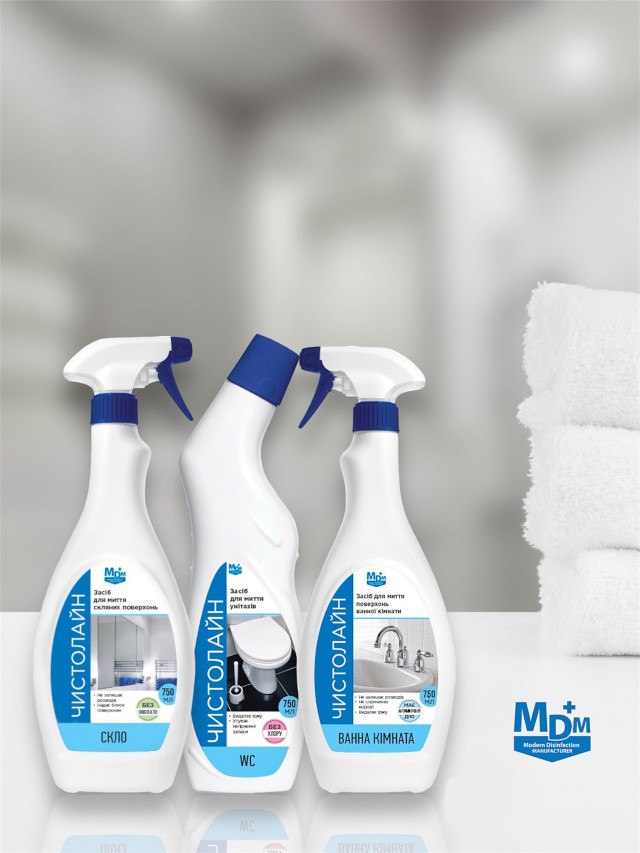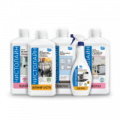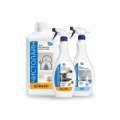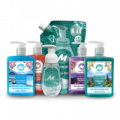Chlorine-free cleaning

Content
Chlorine-containing detergents are very popular – they provide a high level of cleanliness and disinfection, effectively eliminate various types of dirt. But at the same time, they also have many disadvantages related to pungent odor and toxicity. Therefore, many people are looking for high-quality and reliable chlorine-free detergents that could be a great alternative to chlorine. And they do exist.
Harm of chlorine to human health
Chlorine is a caustic toxic substance. It releases fumes into the environment that can affect the respiratory system, skin, and mucous membranes. Chlorine is considered especially dangerous for people with diseases of the cardiovascular and respiratory systems. And products with such an active ingredient become especially dangerous if they are used in small and poorly ventilated rooms, including bathrooms and toilets (and these places are often cleaned with such household chemicals).
Chlorine can cause allergic reactions, eye irritation, and skin damage. It is poisonous to living organisms, so all work with it requires the use of protective equipment (gloves, goggles, respirator), as well as thorough ventilation after cleaning.
Among other things, chlorine can react with organic matter in the environment, such processes are accompanied by the formation of dangerous carcinogenic toxins, and they, in turn, can provoke disorders in the activity of the immune system and the endocrine system.
Chlorine-free detergents: features and properties
Chlorine-free cleaners can contain a variety of active ingredients, including detergents such as surfactants. They ensure effective removal of contaminants. However, since chlorine-containing products are commonly used as disinfectants, alternative products should contain antimicrobial components, such as:
- Alkyl dimethylbenzyl ammonium chloride It is a quaternary ammonium salt and is widely used as an antiseptic and disinfectant to kill bacteria, viruses, and fungi on various surfaces. It is effective in fighting pathogens and ensures that water and surfaces are disinfected.
- 2-Phenoxyethanol (or phenoxyethanol) It is an organic compound widely used in cosmetics and detergents as an antiseptic, preservative, and fragrance. It has the ability to destroy or inhibit the growth of microorganisms such as bacteria and viruses. This makes it a useful ingredient in detergents, where it is important to prevent the spread of infections and ensure the safety of surfaces.
- N,N'-bis(3-aminopropyl)dodecylamine It plays the role of an antiseptic - it destroys and inactivates pathogens (viruses, fungi and bacteria), preventing the spread of bacteria. It also acts as a surfactant - it helps to break down and remove dirt, grease and other impurities.
- Didecyldimethylammonium chloride (DDAC) It is a quaternary ammonium salt that is often used as an active ingredient in disinfectants and antiseptics. It has powerful antimicrobial properties, making it an effective agent for killing various types of bacteria, viruses, fungi, and other microorganisms. It also helps to remove impurities.
Which chlorine-free detergents to choose?
When choosing chlorine-free detergents, it is first necessary to determine their purpose. Such goods can be used:
- For daily cleaning of homes, common areas and medical facilities. These are detergent disinfectants, they provide reliable removal of various types of contamination and simultaneous sanitation - removal of pathogenic microorganisms or inhibition of their activity. These are the functions performed by Chistoline Universal is a detergent that can be used to treat various surfaces, from the floor to plumbing and furniture. For washing dishes (including in medical institutions), you can use the detergent disinfectant Chistoline Utensils, and if you choose chlorine-free toilet bowl cleaners, give preference to the concentrate Chistoline Bathroom.
- For detailed disinfection. In this case, it is better to give preference to more specialized products. As a rule, we are talking about concentrated disinfectants, and they can already be used for both cleaning and targeted disinfection. Excellent chlorine-free disinfectant – Virapav. For use in medical institutions (including disinfection of linen, tableware and disinfection of blood and biological secretions - chlorine-containing agents are often used for these purposes), you can choose Sangesin or Septamine. They can also be used as chlorine-free septic tank cleaners. And for more thorough and gentle processing (including chemical sterilization), you can use Vernedor.
Before using chlorine-free disinfectants, it is necessary to read the manufacturer's instructions. Detergents and disinfectants are available in concentrated form, and their effectiveness largely depends on the level of dilution.






